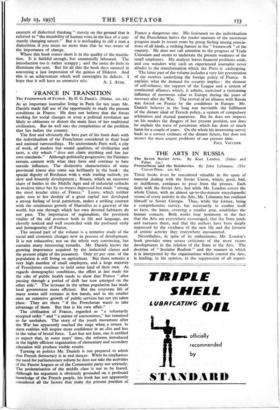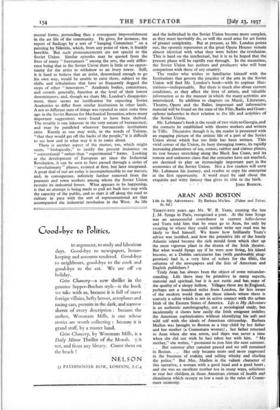THE ARTS IN RUSSIA
Prometheus and the Bolsheviks. By John Lehmann. (The CSCSSet Press. I2S. 6d.) THESE books must be considered valuable in the spate of material dealing with the Soviet Union; which, good, bad, or indifferent, continues to pour- from the presses. Each deals with the Soviet Arts; but while Mr. London covers the whole Union, with an almost up4o-the-minute encyclopaedic résumé of every activity in the Arts, Mr. Lehmann has confined himself to Soviet Georgia. Thus, while the former, being a comprehensive survey, has necessarily to confine itself to facts, the latter, covering a smaller area, establishes the human contacts. Both works bear testimony to the fact that the Arts are everywhere encouraged, that the State tends and nurtures them, and that the authors have been deeply impressed by the vividness of the new life and the ferment of artistic activity they everywhere encountered. ' -
Nevertheless, in spite of its enthusiasms, Mr. London's book provides some severe criticisms of the more recent developments in the relation of the State to the Arts. The doctrine of " Socialist Realism " and the manner in which it is interpreted by the organisations which control the Arts, is leading, in his opinion, to the suppression of all experi- mental forms, portending thus a consequent impoverishment in the art life of the community. He gives, for instance, the report of findings by a sort of " hanging Committee " on a painting by Nikritin, which, from any point of view, is frankly horrible. But such pronouncements are not special to the Soviet Union. Similar episodes may be quoted from the lives of many " forerunners " among the arts, the only differ- ence being that in the Soviet Union there is little or no oppor- tunity for the artist to withdraw to an ivory tower. Still, it is hard to believe that an artist, determined enough to go his own way, would be unable to exist there, subject to the shifts and tribulations that have so frequently dogged the steps of other " innovators." Academic bodies, committees, and crowds generally, function at the level of their lowest denominators, and, though we share Mr. London's disappoint- ment, there seems no justification for expecting Soviet Academies to differ from similar institutions in other lands. A not so different state of things was reputed to exist some time ago in the Soviet Bureau for Mechanical Invention, where many important suggestions were • found to have been shelved. The trouble is one inherent in the very nature of bureaucracy, and 'may be paralleled wherever bureaucratic institutions exist. Keenly as one may wish, in the words of Tolstoy, "that they would get off the backs of the people," it is difficult to see how and in what way it is to come about.
There is another aspect of the matter, too, which might seem, " biologically," to justify the present insistence on " conventional " rather than " experimental " forms. Looking at the development of European art since the Industrial Revolution, it can be seen to have passed through a series of " revolutionary " phases, resisted at first, but later integrated. A great deal of our art today is incomprehensible to our masses, and, in consequence, infinitely further removed from the peasants and town workers among whom the Soviet Union recruits its industrial forces. What appears to be happenings is that an attempt is being made to pull art back into step with the capacity of the public, and to start it off along the road to culture in pace with the sort of representational art that accompanied the industrial revolution in the West. • As life and the individual in the Soviet Union become more complex, as they must inevitably do, so will the need arise for art forms Of greater complexity. But at present, as Mr. London points out, the operatic repertoires at the great Opera Houses remain
almost identical with what they were before the revolution. This is hard on the intellectual, but it is to be hoped that the present phase will be rapidly run through. In the meantime, the Soviet Union has authors and producers who will bear comparison with those of any country.
The reader who wishes to familiarise himself with the Institutions that govern the practice of the arts in the Soviet Union will find Mr. London's book—with its copious illus- trations—indispensable. But there is much also about current conditions, as they affect the lives of artists, and valuable information as to the manner in which the many activities are interrelated. In addition to chapters on Music, Literature, Theatre, Opera and the Ballet, important and informative material will be found on the state of the Film, Radio and Gram- ophone industries in their relation to the life and activities of the Soviet Union.
Mr. Lehmann's book is the result of two visits to Georgia, and the contacts he established with theatre workers and writers in Tiflis. Discursive though it is, the reader is presented with an engaging picture of the artistic life of a part of the Soviet Union about which but too little has been written. This vivid corner of the Union, its busy thronging towns, its rapidly increasing plantations of tea, cotton, .rubber and citrous plants, its rest houses stretching along the Black Sea Coast, and its remote and unknown clans that the centuries have not touched, are destined to play an increasingly important part in the economics of the Soviet Union. Not a few readers will envy Mr. Lehmann his journey, and resolve to copy his enterprise at the first opportunity. A' word must be said about the exquisite and witty fantasy that gives its title to the bbok.
JOHN RODKER.































































 Previous page
Previous page